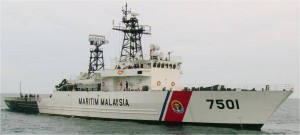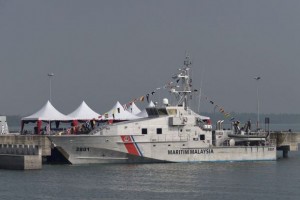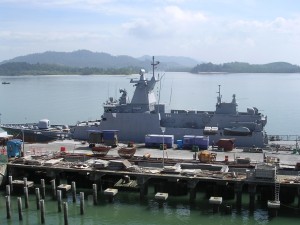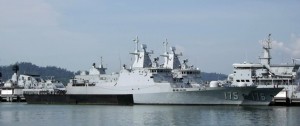SHAH ALAM: TWO German-designs are said to be in the running for the project to replace the two 30-year-old Langkawi-class OPVs operated by the Malaysian Maritime Enforcement Agency (MMEA). Funding for the new OPVs was announced in the 2016 budget.
Prime Minister Datuk Seri Najib Tun Razak when tabling the budget stated that the government has allocated RM864 million to the MMEA for the procurement of new OPVs and patrol boats.
The two Langkawi class OPVs, KM Langkawi (ex KD Musytari) and KM Banggi (ex-KD Marikh) had been in service with MMEA since 2008. Both ships were originally commissioned into the Royal Malaysian Navy in 1987, mostly for patrols in the Malaysian Exclusive Economic Zone in the South China Sea. Both were originally armed with a 100mm main gun and a twin 30mm cannons. It is likely both no longer operate the guns.


The two ships – one built in South Korea and the other at the Malaysian Shipyard & Engineering in Johor under a technology transfer programme – were supposed to herald a new age of maritime industrialisation for the country.
However, no further ships of the same class were ordered as the government then tacked to another direction following a proposal for a tri-nation ship-building project with Australia and New Zealand.


The proposed tri-nation project failed to materialise as the RMN could not agree to the vessel proposed by the Australians. They wanted a smaller vessel, basically a patrol vessel but RMN wanted something more capable than the OPVs (Musytari and Marikh), the so-called New Generation Patrol Vessel (NGPV).
After a period of economic up=and downs, the NGPV design was finally selected, the Mek0 100, from the German Naval Group which had teamed up with PSC Bhd. With the selection of the design, the ship building industry also made another turn when the contract for the NGPV was signed in late 1998.


As part of the deal, the company took over the Naval dockyard in Lumut where the NGPVs were supposed to be completed and build. The facility has since been renamed as Boustead Naval Dockyard after the Boustead group took over the NGPV project around 2005 after PSC was ran into financial difficulties.


The New OPV
Like the MMEA NGPC, the new OPVs are expected to be built locally – at least one – most likely at the the Labuan Shipyard which is 50 per cent owned by the Radimax Group.
At Lima 15, Malaysian Defence reported that Radimax Group “had teamed up with BAE Systems to offer the Amazon class OPV to meet the requirements of the MMEA.” However, Malaysian Defence has been told that the proposed industrial collaboration has fallen through for various reasons.
As it is, the OPV under consideration according to industry sources have now been narrowed down to two German designs, namely, the Fassmer 80m OPV and Lurssen 85m OPV. It is likely only one design would be presented for approval. The new OPVs are expected to be around 1,800 tons, equipped with a flight deck and hangar for a medium size helicopter and a top speed of more than 22 knots.
Fassmer 80M OPV
At least six of the Fassmer 80m OPVs are currently operated by the Chilean and Colombian navies with another four to be completed soon. Notably all of these vessels were built in Chile and Colombian shipyards, respectively, with the cooperation of foreign companies.
Fassmer designed the OPV to meet the requirement of the Chilean navy which subsequently marketed the design to other South American countries, Apart from Colombia, Argentina had also signed for the same OPV. However, the Argentinian project never took off, most likely due to the country’s economic difficulties.
These OPVs are armed with a 40mm main gun with HMG mountings, aft and a flight deck and hangar for a medium-size helicopter like the Airbus Helicopters Dauphin. The latest Chilean OPV is armed with a 76mm main gun though and had a strengthened hull for operations in the Antarctic.
Lurssen 85 metre OPV
As the MMEA requirement calls for a flight deck and hangar for a medium size helicopter, Lurssen’s 85m OPV design is expected to be offered for the programme.
The design is a variant of the Darussalam class OPV of the Royal Brunei Navy, which has a flight deck for a medium-size helicopter but no hangar.
Compared to the Chilean and Colombian OPVs, the Brunei ships despite their designation are considered main combat vessels and therefore are armed more heavily. The four Darussalam class OPVs are fitted with Exocet SSMs while three are armed with a 57mm main gun and two 20mm guns. The fourth OPV, KD Darultaqwa is equipped with a 27mm main gun and twin 20mm guns.
Guns and other things
It is unlikely that the new MMEA OPV will be equipped with missiles though a 57mm gun – similar to the RMN’s new LCS – could still be chosen as the main armament. MMEA is likely to opt for a 30mm gun as the OPV main gun like its NGPC of which six are being built. MMEA could also opt for fitted for but not equipped for the OPV when it comes to the armaments suite if need be.
Apart from the embarked helicopter, it is likely that the OPV will also operate with a UAV though it is unclear whether the builder will be the one which decide on the air vehicle to be chosen.
Analysis
On paper, the Lurssen design which is likely to be fitted with MTU engines must be the odds-on favourite to win the contract. MMEA like the RMN has long term maintenance and support contract with MTU Services (M) Sdn Bhd, one of the main factors in the selection of any ship’s entry into both fleet. Even the two ex-Bay class patrol boats are fitted with MTU engines as did the proposed ex-US Navy Mark V boats.
However, as all of the Darussalam class were built in Germany (as shown by the picture below), building the new variant – even just one- locally will add complexity and costs to the project.
If the Lurssen design, is chosen, it will be a second coming for the German shipyard in Malaysia. The RMN still operates nine ships built at the former Hong Leong Lurssen shipyard, seven Jerong class FACs and the two hydrographic ships. Many of the patrol boats (ex-Marine police) operated by MMEA, were also build at the same shipyard.
Meanwhile, the Fassmer OPV has better potential for local collaboration as it had been built in two different shipyards in South America. As the MMEA OPVs are to be built locally, the track record of the Fassmer design cannot be taken lightly.
That said it will probably be cheaper and faster for the two new OPVs to be built either at the Chilean or Colombian shipyards which are already building the same design.
One thing that may work against the Fassmer design is the engines. The current batch of Chilean and Colombian vessels are fitted with Wartsila diesels. If the Fassmer design is selected, MTU diesels will probably be the engines of choice due to the reason mentioned above. The NGPC, which is also a Fassmer design, is also to be fitted with MTU engines.
— Malaysian Defence
If you like this post, buy me an espresso. Paypal Payment
View Comments (20)
Is it still the 2 units, or more?
Reply
Only two funded
Better with fassmer design. Good thing is we need all those hulls to safeguards our coastline. Hopefully the numbers of hulls of both ngpc and ngpv will be increased. So i guess they will use either the aw139 or the dauphin on these vessels?
Reply
Dauphin is more likely though in emergencies the AW139s could also land and take off from the platforms
Even us coast guard are operating 50+ years old WMEC cutters that are the same size as the langkawi class opv's as one of their main patrolling assets. Is the langkawi class opv's to be sold off? Or still to be operated alongside the new opv's?
Reply
Not sure about that
Anything larger than 1K tonne is waste of money.
The fassmer opv is a very good and affordable (costs quoted around Usd 38mil each) design. Basically it could perform a role that the current kedah sgpv (in the current not fitted with missiles) performs.
Would this type of opv's better be operated under tldm (named after states as per the old patrol boats, as the real addition to the sgpv's seeing the gowinds are really frigates?) or be under the Mmea?
Reply
Yes I think which ever design chosen would probably be good for RMN as a replacement for the PCs and FACs still in service and also the Kedah class
Salam Tuan,
Why our country always like this ? Why not we use same base model , for example the Teguh Samudera than modified according to our needs. Later when we have enough knowledge then we can offer @ sell to other nation.
Why not Teguh Samudera or Kedah Class ? Please enlighten me...
I'm so envy ST Marine, when we gonna learn.
Have to agree with Mohd Wafi, another totally new design, for how many? Only 2 unit.
We have previously acquire the design for Kedah, Teguh Samudera & Gowind. Why can't we use the above as the base design for new class of ships regardless for RMN or APMM.
Even Gowind started from OPV base design, L'Adroit.
@ mohd wafi
A great suggestion by you.
The samudra's cost about the same as the fassmer opv's. The meko100 design could in theory be built at cheaper cost as their design is already owned by malaysia (a modified meko100 design for Israel built by Germany costs about 100mil each. If we strive hard enough probably we could build one, without all those expensive electronics of the kedah class for 60-70mil?)
As for exports, look at korea (bought the 209 submarine design and exported to Indonesia) and Indonesia (bought the makassar lpd design from korea and exporting them to Philippines) no issues of exporting, even competing with the original design companies. I really believe that malaysia could become something like them, and we could export meko100 opv and gowind frigates. Saudi Arabia is looking to upgrade its naval fleet; Australia and the UK are looking at new ships too. I believe we could export naval ships, especially those based in the gowind frigates as in my opinion it is one of the best light frigate design to date.
I will go with fassmer design. No need to be built in Malaysia coz only 2 unit ma.... Used the balance to buy some drone or uav with be more beneficial.
Unrelated but latest news:
Saudi Arabia has announced a 34 country alliance against terrorism, and malaysia is in the list...
http://news.yahoo.com/saudi-arabia-announces-34-state-islamic-military-alliance-002409921.html